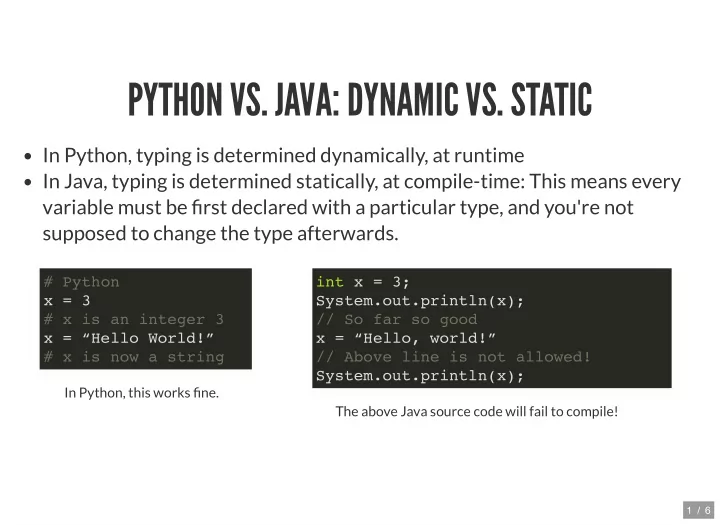

PYTHON VS. JAVA: DYNAMIC VS. STATIC In Python, typing is determined dynamically, at runtime In Java, typing is determined statically, at compile-time: This means every variable must be �rst declared with a particular type, and you're not supposed to change the type afterwards. # Python int x = 3; x = 3 System.out.println(x); # x is an integer 3 // So far so good x = “Hello World!” x = “Hello, world!” # x is now a string // Above line is not allowed! System.out.println(x); In Python, this works �ne. The above Java source code will fail to compile! 1 / 6
PYTHON VS. JAVA: TOTALLY OOP VS. VARYING DATA TYPES Python is fully object-oriented. When you do x = 3, that 3 is actually an object (it has methods, etc.) In Java, there are two different types of data: Primitive types : There are 8 of them in Java - byte, short, int, long, �oat, double, char, boolean (e.g., 3 in Java would be stored as a primitive type). A primitive variable only stores a value. They are not objects. Class types : This would be all other types, provided by Java or created by you. (e.g., String is a class type. There are also wrapper classes for primitive types when you want to treat such values as objects -- e.g. the Integer class type) 2 / 6
WRAPPER CLASSES Every primitive type has a wrapper class version. It can be used to represent a primitive value when an Object is needed. Integer i2 = new Integer(5); Boolean b2 = new Boolean( false ); System.out.println(i2); System.out.println(b2); // Java can automatically "box" a primitive into // an instance of its wrapper class. Integer x = 6; // automatically does Integer x = new Integer(6) // And it can automatically "unbox" a wrapper object // to get the primitive value. int y = x + 4; // automatically does int y = x.intValue() + 4; 3 / 6
Another example of boxing/unboxing: // First we do everything very explicitly. int n; n = 42; Integer boxed; boxed = new Integer(11); // Now we take some shortcuts and know that Java will box and // unbox int values for us, as needed. boxed = 11; // exact same thing as boxed = new Integer(11) boxed = n + 3; // boxed = new Integer(42 + 3) --- 45 n = boxed + n; // n = boxed.getValue() + n --- 45 + 42 = 87 System.out.println("n is " + n + " and boxed is " + boxed); // What would the output of this be? Integer q = 2; Integer w = q; q = 4; System.out.println(w); System.out.println(q); 4 / 6
CONVERTING DATA TYPES Sometimes, when you assign a value of type A to a variable of type B, Java automatically converts the value to type B. Think of the primitive data types dealing with numbers in the following order: double (64 bit �oating point number) �oat (32 bit �oating point number) long (64 bit integer; -2^63 to 2^63 - 1) int (32 bit integer; -2^31 to 2^31 - 1) short (16 bit integer; -2^15 to 2^15 - 1) byte (8 bit integer; can store numbers from -128 to 127) 5 / 6
Converting up this list is done automatically. i.e. If I do: short x = 207; long y = x; the short x is converted to a long y automatically. Similarly, if I do float i = 4; the 4 is an int but this statement will auto convert it to a �oat, so 4.0 gets stored as i's value. To convert down the list though, you have to explicitly cast it, like so: float f = 5.6f; int i = (int) f; Note: In addition to the above, a char can be auto-converted converted to an int and up (the ASCII value of the character). 6 / 6
Recommend
More recommend